
Credits: UF/IFAS
Millions of people in the United States are injured from venoms produced by insects and other arthropods each year. About 25,000 severe injuries result from these bites, and about 32 are fatal.
Venoms
Venomous insects and other arthropods produce venoms that can be classified as:
- Venoms that produce blisters, or vesicating toxins (e.g., blister beetles, certain stinging caterpillars, millipedes).
- Venoms that attack the central nervous system, or neurotoxins (e.g., black and brown widow spiders, bark scorpions, certain ticks, Hymenoptera, wheel bugs).
- Venoms that destroy tissue, or cytolytic and hemolytic toxins (e.g., Hymenoptera, fire ants, ground scorpions, mites, chiggers, wheel bugs, brown recluse spider).
- Venoms that prevent blood from clotting, or hemorrhagic toxins (e.g., lice, fleas, ticks, mites, true bugs, biting flies).
Allergic Reactions
Allergic reactions are often more important than the toxic effects of arthropod venoms. Of individuals who die from arthropod venoms, 96% had an allergic reaction. Allergic reactions are classified according to the severity:
- Slight general reaction: inflammation, welts, itching, malaise, and anxiety.
- General reaction: a slight general reaction, plus two or more of the following symptoms: swelling, wheezing, abdominal pain, nausea, or vomiting.
- Severe general reaction: any of the above, plus two or more of the following: difficulty in breathing, difficulty in swallowing, hoarseness, confusion, or feeling of impending disaster.
- Shock reaction: any of the above, plus two or more of the following: cyanosis (blue coloration of skin and lips from lack of oxygen), fall in blood pressure, collapse, unconsciousness, or incontinence.
Insect stings result in rapid progression of toxic effects. Death can occur within one hour after the person has been stung by a Hymenopteran (bees, fire ants, wasps, yellow jackets, or hornets). Spider bites, however, have a longer time interval between bites and death, with victims dying more than 12 hours after being bitten. Statistics also reveal that of snakebite fatalities, death occurs one to 12 hours after being bitten, and there also have been a larger number of snake bite fatalities in which death occurs 12 hours to two days after a snake bite.
What to Do
Insect stings require quick, prompt action.
- If possible, the causative organism must be captured, saved, and identified.
- If a general allergic reaction is suspected, or the victim has a history of hay fever, allergy, or asthma, a doctor should be contacted immediately.
- Venom that is hemolytic, hemorrhagic or vesicating can cause marked swelling or discoloration at the sting or bite site. Keep the victim warm and quiet until a physician is reached.
- Venom that is neurotoxic can cause little or no swelling or discoloration at the sting or bite site. Apply ice to the site or immerse the affected part of body in ice water until a physician is reached.
- Persons who have exhibited a severe allergic reaction in the past to arthropod venoms or have a history of asthma, hay fever or allergies should:
- Undergo skin testing to determine hypersensitivity to arthropod venoms.
- Carry identification or tags noting hypersensitivity.
- Consider desensitization (immunization).
- Carry an insect sting kit (available only with a physician's prescription).
Prevention of Stings
Several procedures can be used to minimize the danger of being stung by venomous arthropods.
- Avoid mowing lawns or working with flowering ornamentals when bees and wasps are collecting nectar.
- Don't walk barefooted in the yard.
- Sweet items like soft drinks, ripened fruits, and watermelons attract bees and wasps. Keep these items covered outdoors. Pick fruit as it ripens, and dispose of rotten fruits.
Some Common Venomous Arthropods
Pertinent information on common venomous arthropods is in Table 1.
Bees
Bees are often confused with wasps. Although closely related, they differ in many ways. Bees feed pollen and nectar to their young. They are beneficial insects that pollinate fruits, vegetables, and many other plants. The most common bees are the honey bee (Figure 1), bumble bee (Figure 2), and carpenter bee (Figure 3). Bees are not commonly serious problems and usually require no control.
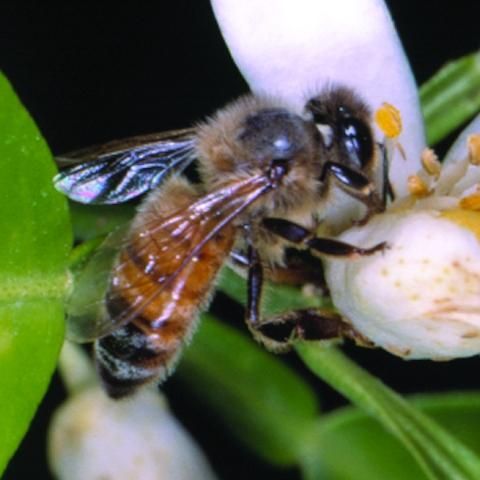
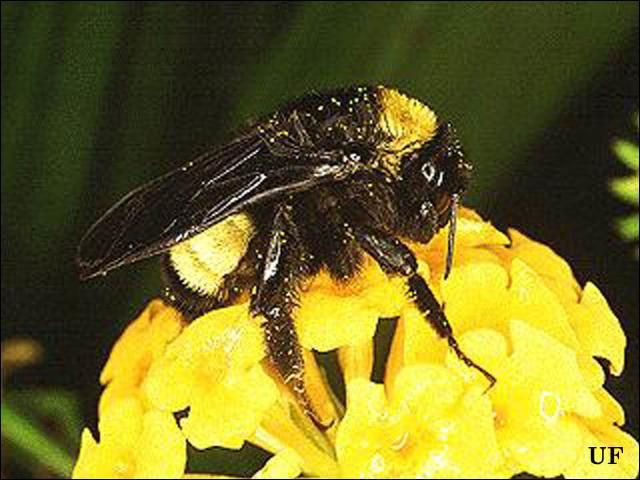
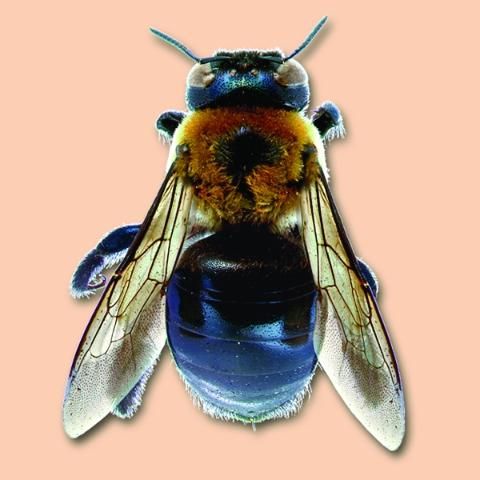
When stung by a honey bee, scrape the bee's stinger out of the wound immediately. Be careful not to pull it out. If you do you may squeeze the venom gland attached to the stinger, which will force poison into the wound. Pull the stinger out by grabbing the base of the stinger below the poison gland. If the stinger is not removed, the poison gland attached to the stinger will continue to pump poison into the wound for several minutes. Unlike wasps and other bees that do not leave a stinger and are capable of stinging many times, the honey bee leaves the stinger and part of its organs attached to the stung animal. In spring and early summer, honey bee colonies divide by swarming. Swarms are not usually a problem unless they land in an inconvenient spot or enter a building. A honey bee colony in a building must be removed after it has been killed to prevent problems from odors of decaying bees, honey, and other pests.
If a bee swarm is undesirable in trees (Figure 4), shrubbery, or buildings, you may wish to contact a beekeeper, county agent, or pest-control company for information on how to remove or kill the bees. Insecticide dusts are effective for killing bee colonies in buildings. Dusts may be applied for effective control. To control bees:
- Locate the colony in the wall at night by tapping and listening for the area of loudest buzzing. Bees keep the nest at 95°F (35°C), so you may be able to feel the heat through the wall.
- At night, drill a small hole in the wall above the colony and apply dust through it or apply dust to honey bee colony entrance.
- Seal all entrances and exits from the colony.
- After two weeks or when all sound and bee activity has stopped, open the wall and remove dead bees, comb, and honey.
- Bury the comb or otherwise dispose of it, so valuable honey bee colonies will not be attracted to the contaminated residue and be destroyed.
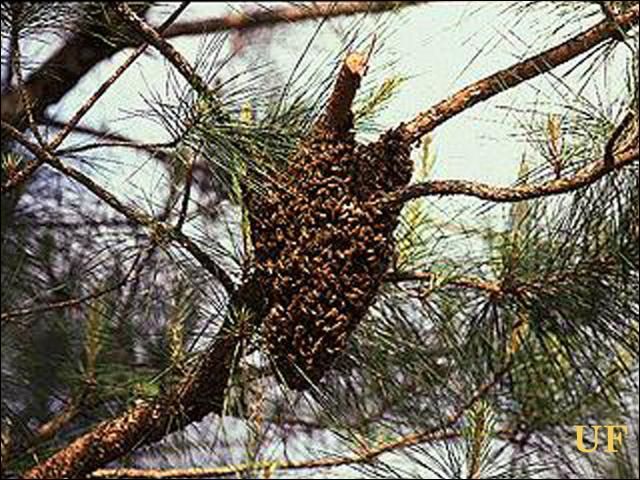
Credit:
Wasps
Hornets, yellow jackets (Figure 5), paper wasps (Figure 6), mud daubers (Figure 7), and cicada killers (Figure 8) all are wasps.
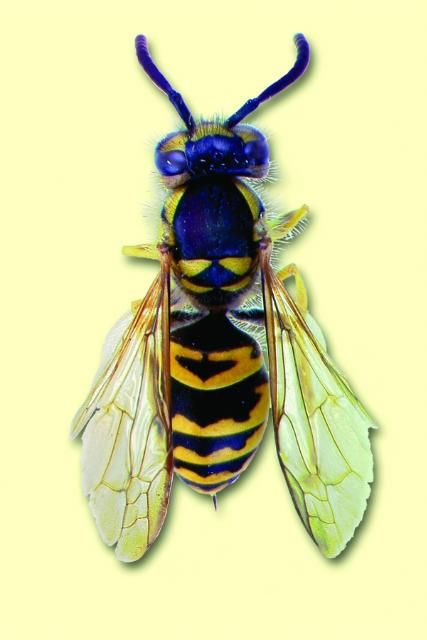
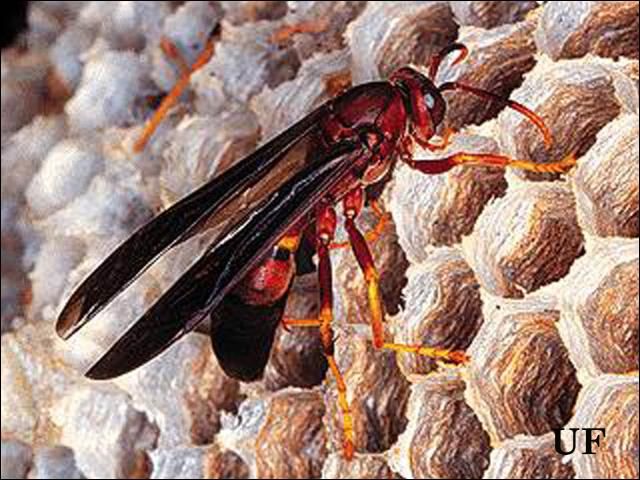
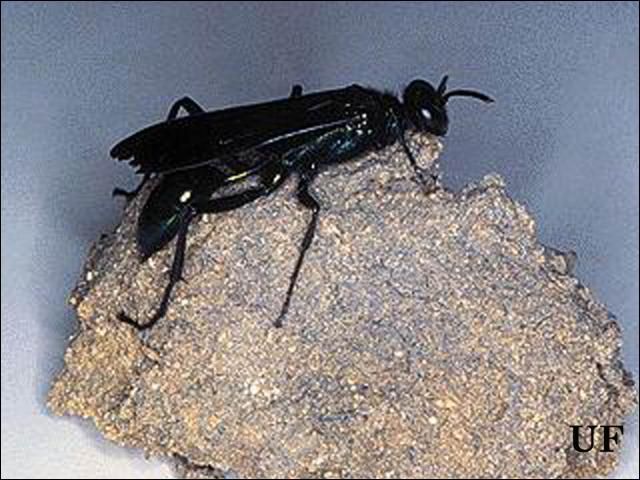
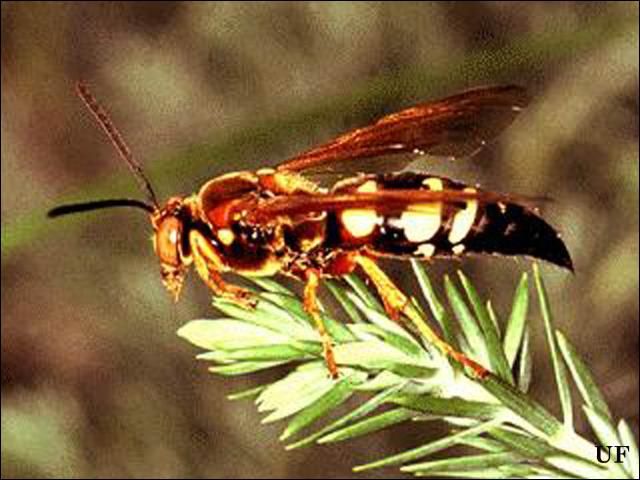
They are generally considered to be beneficial because they attack and destroy many harmful insects found around homes and gardens. Hornets and yellow jackets kill such pests as house flies, blow flies, and various caterpillars. Paper wasps are predators of corn earworms, armyworms and many other garden pests. Though beneficial, wasps also attack people. If disturbed, hornets, yellow jackets, and paper wasps will sting. Mud daubers and cicada killers usually are not as aggressive and will not sting unless touched or accidentally caught in clothing.
Wasps can usually be identified by their nests and their location. Hornets, paper wasps, and mud daubers build nests above the ground. Hornets and paper wasps nest in trees, shrubbery and under eaves. Mud daubers nest under eaves, porch roofs, or similar sheltered areas. Yellow jackets usually build their nests in the ground, but sometimes build them above the ground. Underground yellow jacket nests can be very large and can be very well hidden. Cicada killers nest in the ground. If wasps build nests on houses or in bushes where children play or other activities are carried on, nest destruction or chemical control is necessary.
Hornets and yellow jackets build football-shaped, paperlike nests (Figure 9). Paper wasps build paperlike nests that resemble a honeycomb (Figure 10). Mud daubers build clay or mud-cell nests. Cicada killers dig holes about ½ inch (1.3 cm) across and pile the excavated soil around the opening.
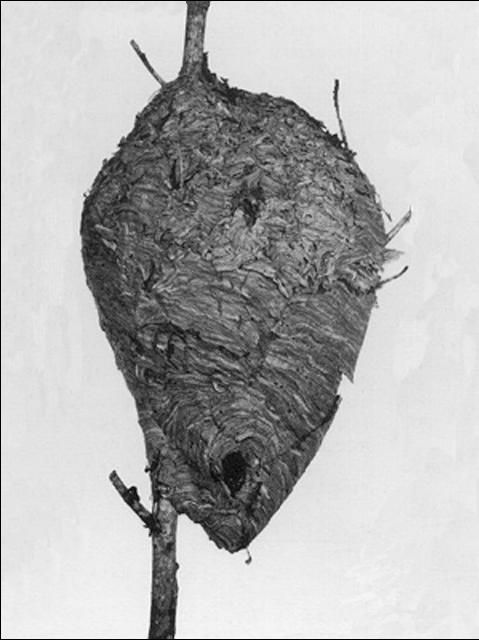
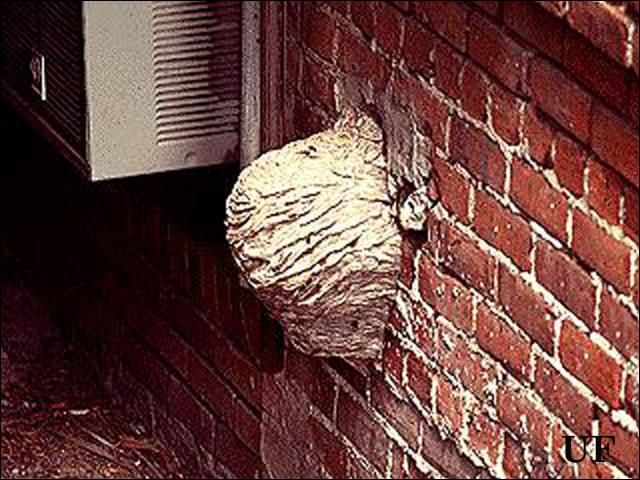
Hornets, yellow jackets, and paper wasps are social insects, and their colonies develop in a similar way. Adult females make up two castes: queens, or fertile females that lay eggs, and workers, or sterile females that feed larvae and may lay eggs without mating if the queen dies during the season. In the fall, queens and males leave the nest and mate. The males die, and the surviving queens hibernate in cracks of rocks, under bark of trees, in buildings, or in the ground. In the spring the queen comes out of hibernation and builds a nest with a few shallow cells. An egg is laid in each cell, and these hatch into worker larvae in two to three days. The queen feeds these larvae, which develop in 12 to 18 days, spin cocoon caps over the cells, and change into pupae. After the first brood emerges, the queen resumes egg laying. The workers take charge of the nest, enlarging it and caring for the new larvae.
Mud daubers are solitary wasps. Each female constructs a clump of mud cells. There is no worker caste. In the spring, young adults come out of their nests and mate. The females then build mud-cell nests. After she completes the nest she captures about 20 spiders, paralyzing each with her sting as she catches it. Spiders are stored in the cell, and she lays an egg on one of the spiders and caps the cell with clay. This is repeated until she has built one nest containing 6 to 20 cells. She may then build other nests in other locations. Once a nest is finished, she leaves it and never returns. The larvae hatch from the eggs and feed on the paralyzed spiders. Complete development takes place in the cell. One to three generations can develop in a year.
The cicada killer is also a solitary wasp. Its habits are similar to the mud dauber, except it constructs its cells in the soil and provisions the cells with cicadas.
When a wasp stings, it injects a venomous fluid under the skin. The venom causes a painful swelling that may last several days. In some cases, a wasp sting may cause severe illness or even death.
Control
Wasps can be easily controlled by applying insecticides to the nest. However, there is usually a certain amount of risk. Nests should be treated at night to minimize the danger of being stung, or protective clothing should be worn. Whatever spray is used, it should have a quick knockdown agent such as synergized pyrethrum or pyrethroids mixed with it.
Control Procedures
For below-ground nests, locate the nest and mark the area so it is easy to find after dark. Use a flashlight covered with a red cellophane paper so wasps stay in their nest. At night, puff dusts into the nest entrance, and immediately throw a shovelful of moist soil over the entrance. Be careful not to step into the nest. For aerial nests, spray nests with pressurized containers with a pin-stream spray from a distance of 20 feet (6 m). Indoor wasp nests should be controlled as honey bee colonies.
Scorpions
Scorpions (Figure 11) are flattened, crablike animals having 10 legs and a fleshy tail ending in an enlarged, upturned tip that bears a stinger. They vary in size from 1 to 4 inches (2.5-10 cm) long. They normally live outdoors, though they will invade homes and buildings. Scorpions will sting, but usually only when provoked or disturbed. Scorpion venom is a neurotoxin, but the dose injected usually is insufficient to prove fatal to an adult human. None of the several species of scorpions that occur in Florida is capable of inflicting a lethal sting. However, the site of the sting may be sore and swollen for some time.
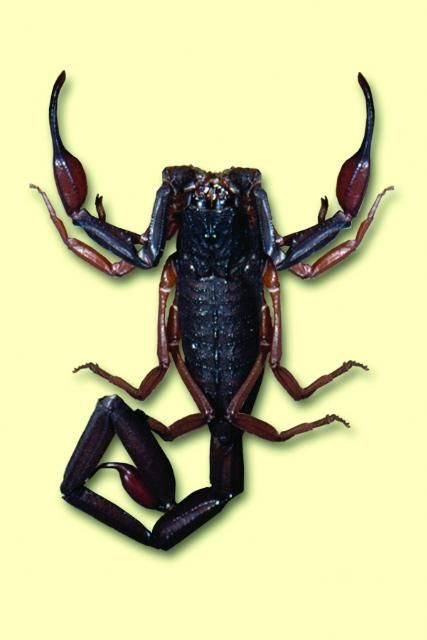
Scorpions are most active at night. They hide under boards, rubbish, or similar debris that provides shelter and protection. Places commonly infested in a home are under the house or in the attic. They feed on insects, spiders, or similar small animal life.
Scorpions have a long life cycle, lasting three to five years. Males and females go through a courtship ritual prior to mating. Scorpions do not lay eggs, and the young are born alive. After birth the young scorpions climb on the back of the mother and remain there until after their first molt. Scorpions are cannibalistic and readily eat their own species. Females often eat their own young.
Control
Mechanically destroy any scorpions found indoors by swatting or crushing. Clean out all possible hiding places. Hiding or breeding areas can be treated with sprays. Ducks and chickens will eliminate most scorpions from around a building. During dry weather scorpions can be attracted and trapped by spreading moist burlap on the ground around infested areas.
Spiders
Almost all spiders in Florida are harmless to man. Most species do not bite unless provoked to attack. The widow spiders, primarily the brown widow, the southern black widow, and the northern black widow, are the most frequently found venomous spiders. See the chapter "Venomous Spiders" for more information.
Fire Ants
Fire ants look like ordinary house ants. However, they are aggressive and capable of inflicting a painful sting. The colony of imported fire ants lives in a mound sometimes 3 feet across. See the fact sheet Managing Imported Fire Ants Urban Areas for more information (https://edis.ifas.ufl.edu/publication/lh059).
Velvet Ant
Velvet ants (Figure 12) belong to a large family, Mutillidae, and are wingless, antlike wasps. The females are solitary with an efficient, large stinger. Most species are parasitic on solitary bees and wasp species.
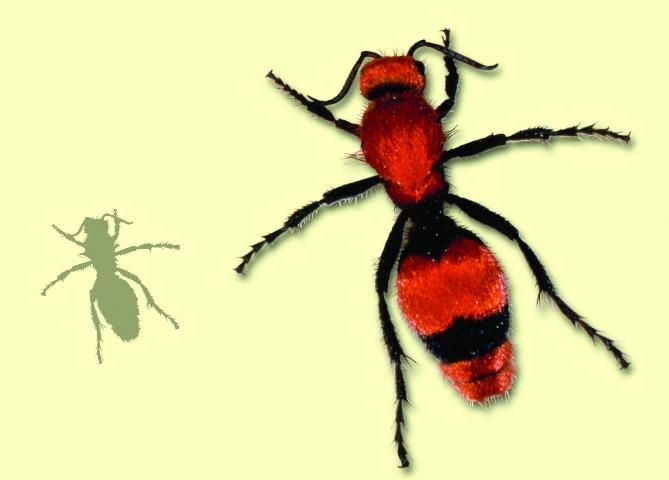
Credit: James Castner, University of Florida
Humans are usually stung by velvet ants when the female is accidentally stepped on with bare feet or trapped against the body in clothing or bedding. Since the velvet ant is solitary and roaming, control is difficult.
Wheel Bug
The wheel bug (Figure 13) is a predaceous bug with a coglike crest on its thorax. They feed on insects; however, humans are bitten by accidental contact. The bug penetrates the skin with its beak and injects a salivary fluid used to kill its prey. The fluid causes an immediate intense pain that lasts three to six hours. The best way to prevent wheel bug bites is to avoid the insect.
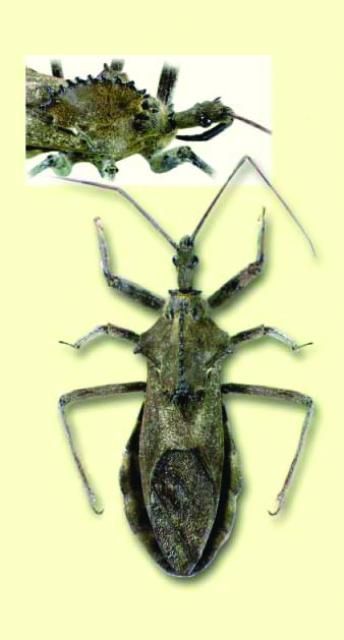
Credit: James Castner, University of Florida
Blister Beetles
Blister beetles (Figure 14) are narrow beetles with a neck that is more slender than the head and wings. Adult beetles can release a fluid that causes blisters on human skin. The larvae of blister beetles are harmless to man and are predaceous on other insects. The adult beetles feed on foliage, and persons often come into contact when moving through infested vegetation. The only suitable control of blister beetles is avoidance of individual beetles or chemical application to crop plants. It is necessary to check recommendations for the crop to determine the chemical to be used.
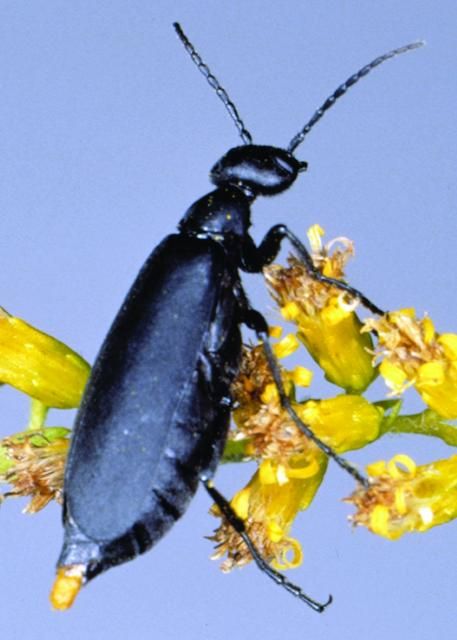
Credit: John Capinera, University of Florida
Stinging Caterpillars
Stinging caterpillars frequently found in Florida are the puss caterpillar, saddleback caterpillar, Io moth caterpillar, and the hag moth caterpillar. These caterpillars feed on vegetation and have spines that can break off in the skin. When the spines break, a toxin flows from the spines onto the skin, causing a burning sensation. When working in an infested area, wear protective clothing. See the chapter "Stinging and Venomous Caterpillars in the Southeast" for more information (https://edis.ifas.ufl.edu/publication/in014).